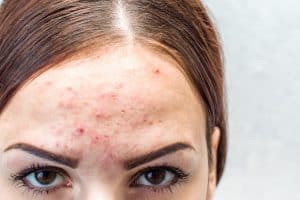Ideal skin expectations are rarely met in real life like we would want them to. The airbrushed covers of magazines display women with perfectly clear and smooth skin, devoid of any of the blemishes that we find disrupting our skin in our everyday life.
One of the most persistent skin conditions that pester people is acne and pimples.

One of the most widespread and well-reiterated methods taken to solving this skin condition is the homemade remedy, of which there are countless versions and recipes. Their one commonality is that most, if not all ingredients used here, are natural and fall under the category of edible produce.
Some of the household names that go synonymous with skin care, and specifically skin lightening are yogurt, aloevera, orange, oatmeal, honey, papaya, tomato, sugar, cucumber, olive oil and even flax seed.
All these have variations in their methods of being prepared, from being powdered, mixed with a wet ingredient like yogurt or juice, to being directly rubbed or applied onto the skin like in the case of tomatoes and papaya. Not only are these vegetables and fruits healthy options for eating, but also do as much good on the outside as they do on the inside.
But little do people know that the area they have ventured into is largely untested and rife with chances of disasters. There are numerous stories out there about horrific reactions that people have had to homemade concoctions. This mostly occurs when people venture away from natural home ingredients like fruits and vegetables, to more ‘creative’ and frankly, risky substances.
One such ingredient which has recently gained popularity is the normal household medicine known as aspirin. “Homemade remedies” when entered into a search engine churns up multitudes of recipes and concoctions. There isn’t any lack of innovation, where even aspirin plays a vital role as an ingredient.
When the ‘expert’ tells you about its anti-inflammatory properties, they fail to mention that the salicylic acid has chances of burning your skin. It helps that they are “natural”, and “inexpensive” but at what cost? And are these benefits enough to overshadow the fact that modern high tech skin care products and medicine work at much faster rates and show healthier results?
Yet another aspect that users conveniently ignore is the quality of the product that they concoct with the help of these homemade recipes. Modern dermatological medicine and products always provide a safety tool that needs more limelight shed on it, and that is the expiry date.
These homemade products on the other hand are often subject to getting spoilt indeterminately and often last only a few days. So the next time a website suggests that you can “store it in the fridge for future use” remember that all you will be applying on your face later would be an expired mush that’s probably not going to help your skin.
Many supporters of homemade remedies often carry the same slogans, and stand by similar benefits of the product and they aren’t always wrong. It is after all a cheaper alternative, and with the use of known ingredients such as fruits, and yogurt it instils a certain feeling of safety using the homemade product.
But any perceptive individual would first check for all possibilities before settling for the DIY version. It all comes down to the matter of belief we have on the scientific field of dermatology and the basic idea that learned people are prone to know better than your average neighbourhood aunty (unless she herself is a dermatologist, in that case you’re just lucky).
Apart from the six to seven simple skin conditions that an average person may be aware of such as pimples and blemishes there are hundreds of other, far more complex and often difficult to detect skin abnormalities and conditions. These can only be identified and appropriately treated by practising dermatologists.
So the next time you look to make your own face wash at home, it will not hurt to look at your other more sophisticated and advanced options such as CureSkin, at least learn about them and turn “unknowns” into “knowns” before taking matters into your own hands.





